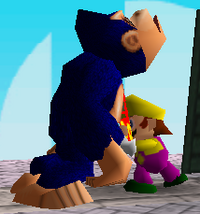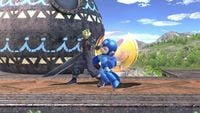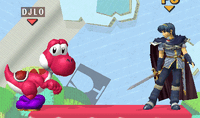Grab
A grab (つかみ / 掴み) is an attack all characters possess which causes them to hold an opponent in place, usually in preparation for a throw or some other followup attack.
All characters possess a grab as part of their standard moveset, which can be performed by pressing the shield and attack buttons simultaneously on any controller in any game. Grabs can also be used with the R Button on the N64 controller, the Z button on the GameCube controller, sideways on the D-Pad with the Wii Remote and Nunchuk, the Minus button on a standalone Wii Remote, the L button on a Nintendo 3DS or the ZR button on a New Nintendo 3DS, ZL or ZR on the Wii U GamePad, Classic Controller, and Wii U Pro Controller; L or R on the Switch Pro Controller or dual Joy-Cons, and the SL button on a single sideways Joy-Con.
Two slight variants exist for each character's grab:
- Dash grabs, introduced in Melee, can be used by grabbing while dashing. This carries the momentum from the dash to give the grab longer reach, but dash grabs are generally heavier on end lag and easier to punish than their normal counterparts.
- Pivot grabs, introduced in Brawl, can be used by grabbing immediately after a pivot. This results in the character pivoting and performing a grab with generally the longest reach of their three grab types, and may be useful in varying one's approach. Pivot grabs tend to have more startup than both standing and dash grabs, and more ending lag than standing grabs but less than dash grabs.
Grabs are unblockable and cannot be shielded; they can thus be used as an easy way to open up a hole in an enemy player's defense. Upon a successful grab, the enemy is immobilized for a time. They cannot be held indefinitely, however: after a short amount of time, the grabbed character will break free in a phenomenon known as a grab release. A grabbed character can escape faster by button mashing, but grabs become more difficult to escape as damage accumulates.
During a grab, the grabbing character has access to five potential attacks: a pummel by pressing the A button, or a forward throw, back throw, up throw, or down throw by pressing those respective directions on the control stick. Damage can be racked up before a throw by using multiple pummels, but this runs the risk of the enemy escaping before a throw can be performed.
In the original Super Smash Bros., grabs are notoriously fast and throws are equally powerful. Pummels, up throws, and down throws did not exist, nor did grab releases (aside from Donkey Kong's forward throw). Pressing the A button with an enemy grabbed will input a forward throw, and waiting 1 full second without inputting anything automatically triggers a forward throw as well. Since Melee, the speed and power of most characters' grabs and throws have been toned down and many of the mechanics were introduced which are now widely understood as the series standard.
Several special moves are similarly able to grab and then throw opponents, which are similarly unblockable and put opponents in a unique state compared to normal grabs.
List of grabs
| Character | Description | Characteristic |
|---|---|---|
| All other fighters | For the sake of brevity, any character not specifically mentioned in this list can be assumed to have a standard-type grab involving a simple grab, hold, or clinch from the character's free hand(s). | Standard |
| Bowser Jr. | Deploys a toylike claw from the Koopa Clown Car and grabs with it. | Standard |
| Dark Samus | Whips forwards with her Grapple Beam. | Tether |
| Greninja | Creates a vortex of water in front of itself. | Standard |
| Isabelle | Swings downwards with a net. | Standard |
| Ivysaur | Swipes inwards with both of its vines at once. | Standard |
| Link | ||
| Lucas | Whips forwards with Rope Snake. | Tether |
| Luigi | ||
| Olimar | Extended | |
| Pac-Man | Fires a Boss Galaga's tractor beam from out of his extended palm. | Extended |
| Robin | Creates a small magic vortex. | Standard |
| Samus | Whips forwards with her Grapple Beam. | Tether |
| Toon Link | Fires his Hookshot forwards. | Tether |
| Villager | Swings downwards with a net. | Standard |
| Wii Fit Trainer | Performs a Rowing Squat. | Standard |
| Yoshi | Opens his mouth and stretches his tongue forwards, holding enemies in his mouth on a successful grab. | Extended |
| Young Link | Fires his Hookshot forwards. | Tether |
| Zero Suit Samus | Extends the Paralyzer's plasma whip forwards. | Tether |
Notable grabs
- In NTSC versions of Melee, Samus' grab can be extended to almost two and a half times its usual length using a special input combination. When this is done, her grapple beam also homes in on enemies if the L button is held, being the only tether grab able to do so, but only grabs enemies if the A button is pressed when the tip connects, and still cannot affect aerial opponents. This affects both her normal grab and dash grab, though not her grab aerial.
- In Smash 4, Pac-Man's grab appears to be one continuous beam; however, it actually projects three short-lived hitboxes one after another in front of him, each one further outwards than the last.
Tether grabs and extended grabs
Some characters, instead of grabbing opponents directly, throw forward a long rope- or whip-like object in order to grab opponents. This sort of grab is known as a tether grab, based on the tether recovery ability that many such characters also have (or, in Melee, the wall-grapple). Tether grabs are renowned for their very high range compared to most other grabs, but – particularly in early installments – are also much slower than standard grabs.
Other characters do not have a tether recovery but still possess a grab range that greatly surpasses other characters'. These characters can be said to have an extended grab.
Characters with tether grabs and extended grabs are noted in the table above. In general, characters with tether grabs also have grab aerials, while those with standard or extended grabs do not. Luigi in Ultimate is the exception; he has an extended grab and a grab aerial that cannot tether.
Special moves that can grab
Some special attacks function as grabs (sometimes called command grabs, from the similar concept in traditional fighting games). When their hitboxes are viewed with Melee's Debug Menu, these attacks use the same magenta hitbox color as standard grabs. Grabbing special attacks put opponents in a unique state that is manipulated by the move in some fashion, and have their own independent rules as to whether and how opponents can escape.
- Koopa Klaw (can grab in the air or at close range on the ground, can only throw forward or backward, no invincibility frames); Melee only
- Flying Slam (can grab and sacrificial KO opponents); replaces Koopa Klaw from Brawl onwards
- Egg Lay (traps opponent in an egg, opponent takes half damage until they escape)
- Inhale (Traps opponent inside Kirby or Dedede, opponent can wriggle to affect movement. King Dedede's is noticeably more powerful.)
- Using Inhale, Kirby can also copy Egg Lay, Chomp, Blunderbuss, as well as King Dedede's Inhale.
- Falcon Dive and Dark Dive (grabs opponent in air and propels them away; can be done repeatedly if it connects the first time)
- Flame Choke (grabs opponent and slams them into the ground)
- Chomp (bites opponent several times, then spits them out)
- Force Palm (grabs and throws forwards after about a second, cannot grab in midair or at long range)
- Monkey Flip (latches onto an opponent, can either attack or jump into the enemy to release, or let go)
- Confusion at close range (grabs the opponent, spins them around, and drops them)
- Suplex (grabs opponent and slams them behind the Brawler)
- Nosferatu (traps opponents and damages them while healing Robin)
- Space Pirate Rush (grabs opponent, drags them across the ground, and throws them; can be ended early by jumping)
- Blunderbuss (sucks opponent in at close range can be thrown forwards, backwards, diagonally, or upwards)
- Fishing Rod (throws out line, if the hook connects with a non-shielding opponent, the opponent is hooked and reeled in, then throws them in one of four directions)
- Alolan Whip (grabs opponent, and throws them into wrestling ring ropes, and reacts in three different ways based on when Incineroar attacks when the opponent rebounds back to him)
- Grappling Hook (throws out line diagonally upwards, if the hook connects, the opponent is pulled closer in then thrown, cannot grab opponents already in hitstun)
Properties
An important property of grabs is that they cannot be shielded, completely ignoring a foe's shield and grabbing them out of it; in comparison to other unblockable attacks, grabs are available to the entirety of the cast in all Smash games, preventing foes from overusing their shields against any character. This, along with grabs' generally fast startup, their ability to easily punish out of shield, and most throws allowing the player to execute diverse combos and chains, causes them to be used very prominently in competitive play, constituting the neutral game of characters as a triangle in which grabs beat shields, but are beaten by attacks as they are outranged by them. Grabs also ignore moves that conceptually block attacks, such as those that provide armor and most counterattacks, though they do not work against foes knocked down on the floor (with the only exception being in the original Super Smash Bros.). In Smash 4 and Ultimate, characters also gain invulnerability to grabs for 70 frames after being released from them, preventing chaingrabs and team wobbles; in Ultimate, this is indicated by the released character flashing yellow whilst the grab invulnerability is active.
Grab hitboxes react very interestingly throughout the Super Smash Bros. series when they collide with a regular hitbox that is within a character's grab range. In Super Smash Bros. and Melee, the grab has priority over the hitbox and will completely override whatever hitbox it collided with and grab the opponent; in Brawl, the grab still has priority over the hitbox, but the hitbox will deal full damage to the character that attempted the grab before they proceed to grab the opponent. In Smash 4, however, hitboxes outprioritize grabs; in this situation, the character that attempted the grab will receive full damage and knockback from the hitbox that the grab collided with, and the character that threw out the hitbox will be grab released and take 3% damage (or more if the grab came from a special move and the grab itself dealt damage, like the beginning of Falcon Dive).
Hitting a character with a grabbed foe in Super Smash Bros. causes them to make their hard-damage noise. From Melee onward, if a character grabbing another character is interrupted (that is, hit by an attack), the grabbed character will be sent flying horizontally. In Melee, characters oddly cannot escape from grabs if they are constantly hit by other characters at certain intervals, which is the main cause of wobbling.
In Ultimate, if two players attempt to grab each other at the same time, both players will take minor damage and will perform their grab release animation. This is similar to the 3% damage grab break effect from Smash 4, but affects both characters like a clang. The exact timing of when this can happen is specific to every animation of every character, and may even be assigned to actions that are not grabs. Before Ultimate, port priority was used to determine which fighter's grab was successful in the event of simultaneous grabs colliding.
A particular character can grab only one opponent at once, and similarly, a grabbed character cannot be grabbed by another one before being thrown or released. Prior to Ultimate, the Ice Climbers are able to grab two opponents at once, with Popo grabbing one and Nana grabbing the other. In Melee, when Nana grabs an opponent, she will act independently, being CPU-controlled. In Brawl, Nana is directly controlled by the player during the grab, enabling zero-to-death combos as each Ice Climber re-grabs the opponent immediately after the partner's throw. In Ultimate, Nana cannot grab at all, and does not act while Popo is grabbing and throwing an opponent.
In game modes such as the Subspace Emissary and Smash Run, most enemies which are vulnerable to attacks can be grabbed, pummeled, and thrown.
Initial grab range by game
In Melee
Melee grab ranges by character according to Mew2King's webpage.
- Samus
- Link
- Young Link
- Marth
- Roy
- Yoshi
- Kirby
- Sheik
- Zelda
- Falco
- Jigglypuff
- Mewtwo
- Peach
- Fox
- Luigi
- Donkey Kong
- Ice Climbers
- Mr. Game & Watch
- Ganondorf
- Captain Falcon
- Mario / Dr. Mario
- Bowser
- Pichu
- Ness
- Pikachu
In Brawl
- Olimar's Blue Pikmin 10.1
- Olimar's White Pikmin 10.0
- Zero Suit Samus, Olimar's Red Pikmin 9.75
- Olimar's Yellow Pikmin 9.6
- Samus: 9.2-9.4
- Link: 8.25
- Olimar's Purple Pikmin: 7.5
- Lucas: 7.25
- Toon Link: 7
- Yoshi: 6.75
- Ivysaur: 6.1
- King Dedede: 6
- Charizard: 5.5
- Zelda: 5.3
- Donkey Kong: 5.1
- Squirtle: 5
- Marth, Diddy Kong , Snake: 4.75
- Kirby, R.O.B.. 4.5
- Peach, Fox, Falco, Ness 4.25
- Wario: 4.1
- Bowser, Pit, Meta Knight, Jigglypuff, Ike, Sonic: 4
- Pikachu, Sheik: 3.9
- Lucario: 3.75
- Wolf, Ice Climbers, Mario, Luigi, Mr. Game & Watch: 3.5
- Captain Falcon 3.25
- Ganondorf: 2.75
In Smash 4
- Samus
- Zero Suit Samus
- Link
- Olimar's White Pikmin
- Toon Link
- Olimar's Red, Yellow and Blue Pikmin
- Pac-Man
- Yoshi
- Lucas
- Olimar's Purple Pikmin
- Villager
- Greninja
- Donkey Kong
- Bowser
- Palutena
- Bowser Jr.
- Duck Hunt, Zelda
- Lucario
- Charizard, Rosalina
- King Dedede
- Bayonetta, Dr. Mario, Shulk
- Luigi, Mario, Mii Gunner, Mii Swordfighter
- Corrin, Dark Pit, Falco, Lucina, Marth, Pit
- Diddy Kong, Ness
- Captain Falcon, Mega Man, Mewtwo, Wario
- Sonic
- Mii Brawler, Mr. Game & Watch, Peach, Robin, Roy, Wii Fit Trainer
- Fox, Pikachu
- Ike, Ryu
- Ganondorf, Kirby, Sheik
- Meta Knight
- Cloud, Little Mac
- Jigglypuff
- R.O.B.
Trivia
- Only two characters in the series – Luigi and Link – have had their grab type outright changed, with Link's grab changing from a tether to a standard one, and Luigi's grab changing from a standard one to an imperfect tether. Curiously, both of these changes occurred in Ultimate.
- In SSB and Melee, characters cannot be grabbed by their lower legs or lower arms (in general); the grab bubbles must make contact with a more substantial part of their body. This behaviour does not appear to exist in later games.
- In SSB and Melee, characters hanging on ledges cannot be grabbed, but in Brawl and SSB4 they can. This can be done if a certain character's grab animation is low enough to be able to grab a character hanging from a ledge if the latter character's head is above the ledge. An example video for SSB4 can be seen here.
- In Brawl, it is not possible to grab an opponent that is standing behind the grabber, even if the grab makes contact with a part of the target's body that extends in front of them. In the previous two games, grabs will connect regardless of the opponent's position.
- Grabs are the only non-special moves to not cause the player's controller to rumble (should the feature be turned on) when used, only doing so if the grab connects with an opponent.
See also
References
| Attacks in the Super Smash Bros. series | |
|---|---|
| Standard ground attacks | Neutral attack · Dash attack |
| Tilt attacks | Forward tilt · Up tilt · Down tilt · Crouching attack |
| Smash attacks | Forward smash · Up smash · Down smash |
| Aerial attacks | Neutral aerial · Forward aerial · Back aerial · Up aerial · Down aerial · Grab aerial · Glide attack |
| Throws | Grab · Pummel · Forward throw · Back throw · Up throw · Down throw |
| Get-up attacks | Floor attack · Edge attack |
| Special moves | Neutral special move · Side special move · Up special move · Down special move · Command-input move · Final Smash |



